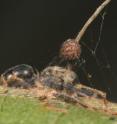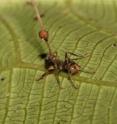Zombie ants have fungus on the brain, new research reveals
Related images
(click to enlarge)
New research has revealed how infection by a parasitic fungus dramatically changes the behavior of tropical of carpenter ants (species Camponotus leonardi), causing them to become zombie-like and to die at a spot that has optimal reproduction conditions for the fungus. The multinational research team studied ants living high up in the rainforest canopy in Thailand. A paper describing the research will be published in the BioMed Central open-access journal BMC Ecology on 9 May 2011. "The behavior of these infected zombie ants essentially causes their bodies to become an extension of the fungus's own phenotype, as non-infected ants never behave in this way," said David P. Hughes, the first author of the research paper and an assistant professor of entomology and biology at Penn State University.
Using transmission-electron and light microscopes, the researchers were able to look inside the ant in order to determine the effect of the fungus on the ant. They found that the growing fungus fills the ant's body and head, causing muscles to atrophy and forcing muscle fibres to spread apart. The fungus also affects the ant's central nervous system. The scientists observed that, while normal worker ants rarely left the trail, zombie ants walked in a random manner, unable to find their way home. The ants also suffered convulsions, which caused them to fall to the ground. Once on the ground, the ants were unable to find their way back to the canopy and remained at the lower, leafy understory area which, at about 9 or 10 inches (25 cm) above the soil, was cooler and moister than the canopy, provided ideal conditions for the fungus to thrive.
The scientists found that at solar noon, when the Sun is at its strongest, the fungus synchronised ant behavior, forcing infected ants to bite the main vein on the underside of a leaf. The multiplying fungal cells in the ant's head cause fibres within the muscles that open and close the ant's mandibles to become detached, causing "lock jaw," which makes an infected ant unable to release the leaf, even after death. A few days later, the fungus grows through the ant's head a fruiting body, a stroma, which releases spores to be picked up by another wandering ant.
"The fungus attacks the ants on two fronts: first by using the ant as a walking food source, and second by damaging muscle and the ant's central nervous system," Hughes said. "The result for the ant is zombie walking and the death bite, which place the ant in the cool, damp understory. Together these events provide the perfect environment for fungal growth and reproduction."
Hughes said his continuing research at Penn State is designed to learn how the fungus might be used to control pest insects in homes and farms.
Source: Penn State
Articles on the same topic
- Zombie ants have fungus on the brainMon, 9 May 2011, 1:30:37 UTC
Other sources
- "Zombie" Ants Bite at High Noon, Then Diefrom National GeographicWed, 11 May 2011, 20:30:34 UTC
- Fungus turns ants into 'zombies'from UPITue, 10 May 2011, 0:30:30 UTC
- And this is how zombie ants lose their mindsfrom MSNBC: ScienceMon, 9 May 2011, 18:00:34 UTC
- Zombie ants have fungus on the brain, new research revealsfrom Science BlogMon, 9 May 2011, 15:00:17 UTC
- Zombie ants have fungus on the brainfrom Science DailyMon, 9 May 2011, 14:30:23 UTC
- Zombie ants have fungus on the brainfrom PhysorgMon, 9 May 2011, 8:01:41 UTC
- Zombie ants have fungus on the brainfrom Biology News NetMon, 9 May 2011, 7:10:07 UTC
- Zombie ants have fungus on the brainfrom Science BlogMon, 9 May 2011, 1:30:15 UTC
- Zombie Ants Bite at High Noon, Die at Sunsetfrom Live ScienceMon, 9 May 2011, 0:30:21 UTC

